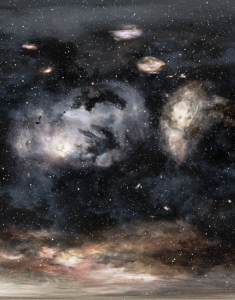Visualizing Interstellar’s Wormhole by Oliver James, Eugenie von Tunzelmann, Paul Franklin, Kip S. Thorne.
Abstract:
Christopher Nolan’s science fiction movie Interstellar offers a variety of opportunities for students in elementary courses on general relativity theory. This paper describes such opportunities, including: (i) At the motivational level, the manner in which elementary relativity concepts underlie the wormhole visualizations seen in the movie. (ii) At the briefest computational level, instructive calculations with simple but intriguing wormhole metrics, including, e.g., constructing embedding diagrams for the three-parameter wormhole that was used by our visual effects team and Christopher Nolan in scoping out possible wormhole geometries for the movie. (iii) Combining the proper reference frame of a camera with solutions of the geodesic equation, to construct a light-ray-tracing map backward in time from a camera’s local sky to a wormhole’s two celestial spheres. (iv) Implementing this map, for example in Mathematica, Maple or Matlab, and using that implementation to construct images of what a camera sees when near or inside a wormhole. (v) With the student’s implementation, exploring how the wormhole’s three parameters influence what the camera sees—which is precisely how Christopher Nolan, using our implementation, chose the parameters for \emph{Interstellar}’s wormhole. (vi) Using the student’s implementation, exploring the wormhole’s Einstein ring, and particularly the peculiar motions of star images near the ring; and exploring what it looks like to travel through a wormhole.
Finally! A use for all the GFLOPS at your finger tips! You can vet images shown in movies that purport to represent wormholes. Seriously, the appendix to this article has instructions.
Moreover, you can visit: Visualizing Interstellar’s Wormhole (I know, same name as the paper but this is a website with further details and high-resolution images for use by students.)
A poor cropped version of one of those images:
A great demonstration of what awaits anyone with an interest to explore and sufficient computing power.
I first saw this in a tweet by Computer Science.
